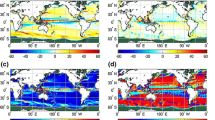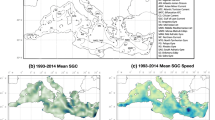Abstract
Presently, two satellite missions, Gravity Recovery and Climate Experiment (GRACE) and Gravity field and steady-state Ocean Circulation Explorer (GOCE), are making detailed measurements of the Earth’s gravity field, from which the geoid can be obtained. The mean dynamic topography (MDT) is the difference between the time-averaged sea surface height and the geoid. The GOCE mission is aimed at determining the geoid with superior accuracy and spatial resolution, so that a more accurate MDT can be estimated. In this study, we determine the mean positions of the Antarctic Circumpolar Current fronts using the purely geodetic estimates of the MDT constructed from an altimetric mean sea surface and GOCE and GRACE geoids. Overall, the frontal positions obtained from the GOCE and GRACE MDTs are close to each other. This means that these independent estimates are robust and can potentially be used to validate frontal positions obtained from sparse and irregular in situ measurements. The geodetic frontal positions are compared to earlier estimates as well as to those derived from MDTs based on satellite and in situ measurements and those obtained from an ocean data synthesis product. The position of the Sub-Antarctic Front identified in the GOCE MDT is found to be in better agreement with the previous estimates than that identified in the GRACE MDT. The geostrophic velocities derived from the GOCE MDT are also closer to observations than those derived from the GRACE MDT. Our results thus show that the GOCE mission represents an improvement upon GRACE in terms of the time-averaged geoid.











Similar content being viewed by others
References
Andersen OB (2010) The DTU10 gravity field and mean sea surface second international symposium of the gravity field of the Earth (IGFS2), Fairbanks, Alaska
Bingham RJ, Knudsen P, Andersen O, Pail R (2011) An initial estimate of the North Atlantic steady-state geostrophic circulation from GOCE. Geophys Res Lett 38:L01606. doi:10.1029/2010GL045633
Cunningham SA, Alderson SG, King BA, Brandon MA (2003) Transport and variability of the Antarctic circumpolar current in drake passage. J Geophys Res 108(C5):8084. doi:10.1029/2001JC001147
Deacon GER (1937) The hydrology of the Southern Ocean. Discov Rep 15:1–124
Gouretski VV, Koltermann KP (2004) WOCE global hydrographic climatology. Tech Rep 35. Berichte des BSH, p 54
Hughes CW, Ash E (2001) Eddy forcing of the mean flow in the Southern Ocean. J Geophys Res 106:2713–2722
Hughes CW, Bingham RJ (2008) An oceanographer’s guide to GOCE and the geoid. Ocean Sci 4:15–29
Marshall J, Adcroft A, Hill C, Perelman L, Heisey C (1997) A finite volume, incompressible Navier-Stokes model for studies of the ocean on parallel computers. J Geophys Res 102:5753–5766
Maximenko N, Niiler P, Rio M-H, Melnichenko O, Centurioni L, Chambers D, Zlotnicki V, Galperin B (2009) Mean dynamic topography of the ocean derived from satellite and drifting buoy data using three different techniques. J Atmos Ocean Tech 26:1910–1919. doi:10.1175/2009JTECHO672.1
Mazloff MR, Heimbach P, Wunsch C (2010) An eddy-permitting southern ocean state estimate. J Phys Oceanogr 40:880–899. doi:10.1175/2009JPO4236.1
Menemenlis D, Fukumori I, Lee T (2005) Using Green’s functions to calibrate an ocean general circulation model. Mon Weather Rev 133:1224–1240
Niiler P, Maximenko NA, McWilliams JC (2003) Dynamically balanced absolute sea level of the global ocean derived from near-surface velocity observations. Geophys Res Lett 30(22):2164. doi:10.1029/2003GL018628
Olbers D, Ivchenko VO (2001) On the meridional circulation and balance of momentum in the Southern Ocean of POP. Ocean Dyn 52:79–93
Orsi AH, Whitworth TW III, Nowlin WD Jr (1995) On the meridional extent and fronts of the Antarctic circumpolar current. Deep Sea Res Part I 42:641–673. doi:10.1016/0967-0637(95)00021-W
Pail R et al (2010) Combined satellite gravity field model GOCO01S derived from GOCE and GRACE. Geophys Res Lett 37:L20314. doi:10.1029/2010GL044906
Sokolov S, Rintoul SR (2002) Structure of the Southern Ocean fronts at 140°E. J Mar Syst 37:151–184. doi:10.1016/S0924-7963(02)00200-2
Sokolov S, Rintoul SR (2007) Multiple jets of the Antarctic circumpolar current south of Australia. J Phys Oceanogr 37:1394–1412. doi:10.1175/JPO3111.1
Sokolov S, Rintoul SR (2009) Circumpolar structure and distribution of the Antarctic circumpolar fronts: 1. Mean circumpolar paths. J Geophys Res 114:C11018. doi:10.1029/2008JC005108
Volkov DL (2005) Interannual variability of the altimetry-derived eddy field and surface circulation in the extra-tropical North Atlantic ocean in 1993–2001. J Phys Oceanogr 35:405–426
Volkov DL, Fu L-L, Lee T (2010) Mechanisms of the meridional heat transport in the Southern Ocean. Ocean Dyn 60:791–801. doi:10.1007/s10236-010-0288-0
Acknowledgments
This work was funded by the NASA Physical Oceanography program and carried out at Jet Propulsion Laboratory, California Institute of Technology, under contract with the National Aeronautics and Space Administration (NASA). The authors thank S. Sokolov, S.R. Rintoul, and A.H. Orsi for providing their estimates of frontal positions. Comments from two anonymous reviewers and the editor K. Heywood are greatly appreciated. Copyright 2011 California Institute of Technology. Government sponsorship is acknowledged.
Author information
Authors and Affiliations
Corresponding author
Additional information
Responsible Editor: Karen J. Heywood
Rights and permissions
About this article
Cite this article
Volkov, D.L., Zlotnicki, V. Performance of GOCE and GRACE-derived mean dynamic topographies in resolving Antarctic Circumpolar Current fronts. Ocean Dynamics 62, 893–905 (2012). https://doi.org/10.1007/s10236-012-0541-9
Received:
Accepted:
Published:
Issue Date:
DOI: https://doi.org/10.1007/s10236-012-0541-9




